
BLUES JUNCTION Productions
7343 El Camino Real
Suite 327
Atascadero, CA 93422-4697
info
- Home
- Letter From the Editor
- Tom Hyslop: A Personal Appreciation
- Top Ten Albums of 2022
- Dave's Top Ten List of Top Ten Lists
- An Appreciation of James Harman
- Album of the Year: The Duke Robillard Band They Called It Rhythm & Blues
- Album Review: Rick Holmstrom Get It!
- Album Review: The Phantom Blues Band - Blues for Breakfast
- Album Review: Bob Stroger & the Headcutters That’s My Name
- Album Review: Hash Brown - Stop! Your Evil Ways
- Archives
- Contact Us
- Links
Hambone
An ingredient for delicious soup,or an instrument for scorn, or for strong rhythm,or for hot sex?
by
Erwin Bosman
In 2009, the Richmond professional baseball team was looking for a new franchise and was about to move to a new home field in Virginia. On this occasion, it wanted to replace its name “The Defenders”. One of the six names on the short list was “The Hambones”. This alternative was dropped when the Virginia state division of the NAACP, the National Association for the Advancement of Colored People, an African-American civil rights organization, spoke out against it, calling it offensive. It said the hambone referred to a dance that slaves had been forced to perform to entertain whites. Its executive director stated, “Hambone was done on the plantation by African captives and was used at minstrel shows to entertain white audiences.” He added, “The fact that it [Hambones] is being considered for use is unacceptable, unfathomable and unconscionable.”
The baseball team apologized immediately noting that it was “unaware of any negative, derogatory, or offensive connotations to the name and that the organization in no way intended to offend any individual or segment of society with its inclusion in the name of the team contest”. In a press release the team explained that the possible name was chosen from different submissions it had received, and its sole intent was to utilize the concept of Virginia Ham and its history in the region. The team finally opted to associate itself with flying squirrels rather than with hambones.
Clearly, there is more to a ‘hambone’ than the bone in ham meat. Join me in the cut off the meat of the bone to try to discover what is behind it. This requires going back in time.
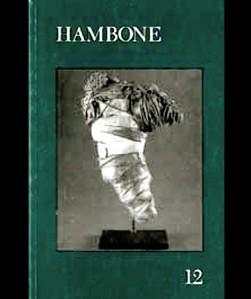
Let us go a bit further back in time. Frankie Laine, aka Mr. Rhythm, was a successful American singer, songwriter, and actor whose career spanned 75 years, from his first concerts in 1930 to his final performance in 2005. He hit the Billboard charts again in 1952 with a song called “Hambone,” sung with Jo Stafford, considered one of the most versatile vocalists of the era. The song was one of Laine’s many top 10 hits and its lyrics went as follows:
“Hambone, hambone
Where you been?
Round the world and I’m going again
What you gonna do when you come back?
Take a little walk by the railroad track
Hambone, hambone
Where’s your wife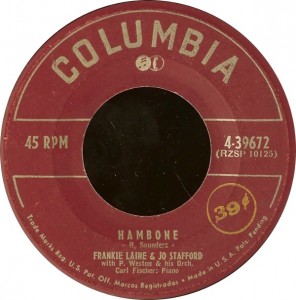
Out to the kitchen, cooking out rice
Hambone
Hambone, hambone
Have you heard?
Papa’s gonna buy me a mocking bird
If that mocking bird don’t sing
Papa’s gonna buy me a diamond ring
If that diamond ring don’t shine
Papa’s gonna take it to the five and dime
Hambone
Hambone, hambone
Trying to eat
Ketchup on his elbow, pickle on his feet
Bread in the basket
Chicken in the stew
Supper on the fire for me and you
Look at him holler, look at him moan
That hambone just can’t hambone
Hambone (…)”
At the same time another singer, Dee Clark, a very successful African American R&B singer of the late 1950s and early 1960s, grew up on Chicago’s West Side. In 1952 he joined with his schoolmates in a group that called itself the “Hambone Kids”. They performed a dance that consisted of slapping their thighs, chests, and other parts of the body. The group remained popular long enough to collaborate with the famous jazz musician Red Saunders & his orchestra for a single, also titled “Hambone,” issued on Okeh in 1952.
The “Hambone” dance and rhythm would be made popular worldwide disguised as the “Bo Diddley beat”, introduced by a fantastic musician born in Mississippi by the name of Ellas Otha Bates. Bates, going by the stage name Bo Diddley, would conquer the hit charts. The “Diddley beat” is a rumba-like beat inspired by a style also displayed by street performers who played out the beat by slapping and patting their arms, legs, chest, and cheeks while chanting rhymes like Dee Clark’s “Hambone Kids”. The “Bo Diddley” drum beat was an immediate hit and, in later years, inspired many other variations in songs like “Not Fade Away” coverd by Buddy Holly and the Rolling Stones, “Willie & the Hand Jive” covered by the Johnny Otis Show and Eric Clapton, “Magic Bus” by the Who, and “Desire” by U2 (Marcus, et. al). These were only the most famous. The “hambone” song has been performed by numerous others (Kirby Stone Four, The Bell Sisters, Orgone, The Black Diamonds,….).
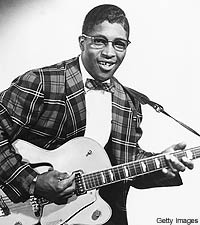 The Hambone rhyme and beat was clearly in the air. Michael Hawkeye Herman, today one of America’s finest acoustic guitarists and blues educators, wrote me some time ago that when he was growing up it was common for folks to participate in hambone at social gatherings and parties and sing a song that goes: “Hambone, hambone, where you been? Around the world and back again”. Meanwhile folks kept and played rhythm with hand claps and body claps and added improvised verses to the song. It corresponds to what Derique McGee, an African American entertainer, circus artist and teacher, who today keeps the art of “hamboning” very much alive, reminisces when he says he learned the act as a child in Berkeley. McGee calls it a “living bit of history, a neglected part of our heritage” (J. Isenhour).
The Hambone rhyme and beat was clearly in the air. Michael Hawkeye Herman, today one of America’s finest acoustic guitarists and blues educators, wrote me some time ago that when he was growing up it was common for folks to participate in hambone at social gatherings and parties and sing a song that goes: “Hambone, hambone, where you been? Around the world and back again”. Meanwhile folks kept and played rhythm with hand claps and body claps and added improvised verses to the song. It corresponds to what Derique McGee, an African American entertainer, circus artist and teacher, who today keeps the art of “hamboning” very much alive, reminisces when he says he learned the act as a child in Berkeley. McGee calls it a “living bit of history, a neglected part of our heritage” (J. Isenhour).
The hambone dance has a long history. C.L. Keyes describes the hambone as a dance derived from the antebellum dance called the “juba”, performed to rhyming verses by the patting and clapping of one’s thighs, chests, hands, and even the top of the head. It goes back to the very roots of black music (W. Erbsen). C.M. Phillips traces its origin to a game played in Congo by young girls, called ‘nsunsa’, that involved crossing the hands underneath and above the thighs. The thigh-and-chest slapping dance imparted confidence and self-spirit. In Brazil it would evolve as the ‘bate coxa’ (meaning literally ‘slap thigh’). In America the game was translated as hambone. The hands are struck, or slapped, and the fingers are snapped in ways that create beat and rhythm in various ways to show the performer’s dexterity in creating percussive rhythms. The ‘hambone’ is a close relative to the ‘tap dance’ that would be popularized in northern entertainment in the 1840′s by the black stage dancer William Henry Lane, billed as Master Juba, one of the greatest dancers of the antebellum period (Malone & Stricklin). Some authors (Conyers) see the pedigree extend even as far as the urban Charleston which became hugely popular in the 1920′s.
The game dimension of the ‘hambone’ is highlighted also in the ‘Encyclopedia of African Music’, edited by Emmett G. Price, one of America’s leading experts on African-American music and culture. Price stresses the vocal elements of the African-American game songs that include repetition of short phrases, the use of non-lexical phrases and the call-and-response structure, which on their turn can be linked to the African ‘ring dance’ and ‘shout’. White & White observe that the hambone was used to introduce the young people into the complex rhythmic patterns needed for the creation of music and dance, a role which it has continued to serve until quite recently. They stress that this function furthermore teaches independence. C.K. Keyes adds that the male teenagers performed the hambone as a courtship game when they rhymed: “Hambone, Hambone, ham in the shoulder / Gimme a pretty woman and I’ll show you how to hold her”.
The central role of drum and percussion in the African (American) culture is essential to the musical understanding of the hambone.
When the Atlantic slave trade of the 1500′s to the South American colonies of Portugal and Spain began, drumming was noted as an important aspect of the gatherings and spiritual ceremonies for the West African slaves (A. Wilson). Drums were played with the hands or with sticks. Additionally, the slaves used it to beat out messages to one another, including warnings about the arrival of a plantation owner. In their culture, the drum and its percussive corollaries were a powerful instrument in the political and cultural unification of their group and were, as such, a cornerstone of their social life (W.R. Scott & W.G. Shade). The communication capacity of drums is also stressed in E. Nielsen’s study of folk dancing when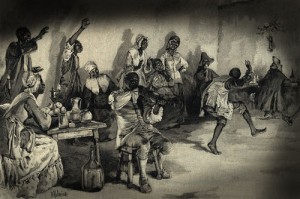 she notices that drums could reproduce some West African dialects.
she notices that drums could reproduce some West African dialects.
It is common to find in literature on hambone as a dance, that it developed or gained importance when the plantation owners started to realize the potential subversive dimension of drums. The plantation owners realized that the drum not only was a means to communicate but was also connected to armed conflict and had been used in African culture to call men to the battle field. Whites gradually understood that the drum could be seen as a focal point of physical and cultural resistance. The disconcerting drum sound became, for the white man, a source of anxiety and fear as it could spread the language of insurgency (S. Gikandi).
Drums were progressively banned by European-Americans during the 18th century, which is a curious observation since the African-Americans were allowed to continue to play the drums in the militia bands (their style was, however, European inspired and approved). Drumming was, for instance, banned in South Carolina in the aftermath of the Stono Rebellion of 1739, the largest slave uprising in the British mainland colonies before the American Revolution (S. Gikandi). A similar prohibitive, legal reaction took place in Virginia, and other states based their legislation on the South Carolina and Virigina model (M. Knowles). The South Carolina Slave Act itself incorporated many of the terms of earlier slave acts of the West Indies, including thebanning of “wooden swords, and other mischievous and dangerous weapons, or using or keeping of drums, horns, or other loud instruments, which may call together, or give sign or notice to one another of their wicked designs or purposes” (quoted in D. Epstein).
I believe the literature makes too strong an association between the banning of drums and the popularity of hambone, almost as if banning the drum was a condition for the popularity of the hambone. It is too simplistic when, for instance, W. Erbsen states that “slaves substituted their own bodies for the outlawed drums and the results were called “Patting Juba” or Hambone”.
I see a few arguments to support my view. In the first place, as previously mentioned, hambone had its roots in Africa. Moreover, it was not only drums which were the target of prohibitive legislation; dancing itself was associated with a sense of defiance. African dances were seen as covers for organized resistance and could function as an alibi for outlawed assembly (S. Gikandi). Much like the drum, dancing could contain messages that were at first glance invisible to the white eye. For instance in Argentina, public dances by slaves known as the “candombes”, were banned three times in the last half of the 18th century. In Brazil, the “candomblé” (dance of slaves) was banned at the beginning of the 18th century. Also in the antebellum American South, the dancing of slaves was observed carefully by the white authorities. V. Sheperd draws our attention to the slave owner’s fear towards slave dances which were regarded as ‘liberated bodies in action.’ Dancing as a recreational institution attracted the attention of legislators because it could act as a metaphor for spiritual, and eventually, physical independence (Sheperd, 227). The dancing could not be totally suppressed and the Roman Catholic church in the Deep South colonies manifested greater tolerance to it than the Upper South Protestant ethics. R.D. Abrahams describes in a lively way the dancing performed by the slaves during the corn shucking feasts, but these were organized by the plantation owners themselves and were very functional for their benefit. If the dancing did not take place in a white controlled context, it was considered ‘heathen’, ‘barbaric’ and potentially dangerous.
Furthermore, hambone was only one of the many dancing styles performed by the African- Americans, which were at the core of their culture. Rhythm was a natural aspect to their way of life and their labor activities. Moreover, dancing was a temporary release from the soul crushing burdens of bondage, and hambone was not the sole dance to fulfill this function. Dancing could take shape in all kind of social gatherings (J.M. Coggeshall). It was enough that “a bunch of people would be sitting around and somebody’d say, “I’ll bet you I can beat you buckin’.” The “buck dance”, “flat footing”, “hoedown”, “jigging”, “sure footing”, and “stepping” are some of the traditional (Appalachian solo) dances. The “rubber leg”, the “camel walk”, the “frog dance” and “rabbit dance”, “pitchin’ hay”, “cuttin’ wheat”, “pony’s prance”, “the swan’s bend”, “the kangaroo” or “shooting the chute” are just a few other names of dance styles that were popular (S. Floyd). The “cakewalk”, another example that was popularized by the black face minstrelsy, is said to have found its origin in the dances performed by the African slaves when they mocked the fancy dance styles and ways of walking of their white owner. The inner rhythms of the African slaves and population found their expression in many dance styles of which the hambone was just one.
The hambone had of course the major advantage of being at disposal any moment as accompaniment to singing. Even when no instrument was readily available, the human body could function as a means of creating rhythm to the singing and dancing. This aspect made it attractive, and each plantation of some size had at least one slave who could ‘pat the juba’ (White and White).
The emphasis placed on the popularity of the hambone in light of the banning of the drums, which supposedly pushed the slaves to use their own body as drumming instrument, further obscures the overall creativity that African-Americans displayed in all aspects of their daily life, work and entertainment. There was no end to their inventiveness and improvisation in the struggle of survival, and this revealed itself in many talents, which very often found their inspiration in their African culture. Miller and Smith sketch how slave carpenters produced all the cooperage that was needed on the plantation, as well as many wooden objects today produced in plastic or metal. The woodworking skills were deployed for making bowls, buckets, washtubs, spoons and boats. They improvised from materials that were at hand. Seats were fashioned of corn shucks. A tree branch was cleverly transformed into a rake or pitchfork. Gourds were remodeled into birdhouses. The talent in handiwork prevailed also during leisure time and was expressed when carving images that had a spiritual meaning, or when creating children’s toys. Slave canes, for example, were often decorated with snakes, alligators or other animals, carved out with a great sense for detail. There was also great talent displayed by the women in creating quilts.
The same creativity and inventiveness was applied to the fashioning of musical instruments, used when they were allowed time to themselves on Saturday nights and Sundays, and for their social gatherings. This amazing dexterity speaks for itself in the words of Wash Wilson, born a slave in Louisiana when he describes the types of musical instruments used at slave dances (K. Hazzard-Gordon):
“Us take pieces of sheep’s rib or cow’s jaw or a piece of iron, with a old kettle, or a hollow gourd and some horsehair to make de drum. Sometimes dey’d get a piece of tree trunk and hollow it out and stretch a goat’s or sheep’s skin over it for de drum. Dey’d take de buffalo horn and scrape it out to make de flute. Then dey’d take a mule’s jaw bone and rattle de sticks ‘cross its teeth. Then day’d take a barrel, and stretch a ox’s hide cross one end and a man sat ‘stride de barrel, and beat on dat hide with he hands and he feet and iffen he get to feelin’ de music in his bones, he’d beat on dat barrel with his head. ‘Nother man beat on wooden sides with sticks.”
The slaves using their own body as musical instrument was thus fully in line and coherent with the genius they not only showed in crafting all kind of objects for use in daily life and for work, but also with fashioning a wide range of other musical tools from all kinds of materials available to them. It was a perpetuation of their traditions as skilled artisans and music makers and performers. As I said, there was no end to their creativity.
 Some authors attribute a major symbolic value to the hambone. It stands for the sharing of information through experience (Ming Fang He and JoAnn Phillion). The hambone refers, as a culinary attribute, to the bone that was passed on from one cabin and family to another, from one soup to another. In this meaning, it is an emblem for passing cultural resistance and survival strategies that are also carried over from one generation to another, just as the hambone was passed and shared from ‘pot to pot’, neighbor to neighbor, to “flavor the soup, each time picking up new flavors and depositing the remains of the previous meal”. To provide fuel for the struggle, it needed to keep going around and around as in the rhyme:
Some authors attribute a major symbolic value to the hambone. It stands for the sharing of information through experience (Ming Fang He and JoAnn Phillion). The hambone refers, as a culinary attribute, to the bone that was passed on from one cabin and family to another, from one soup to another. In this meaning, it is an emblem for passing cultural resistance and survival strategies that are also carried over from one generation to another, just as the hambone was passed and shared from ‘pot to pot’, neighbor to neighbor, to “flavor the soup, each time picking up new flavors and depositing the remains of the previous meal”. To provide fuel for the struggle, it needed to keep going around and around as in the rhyme:
“Hambone, hambone
Where you been?
Round the world and I’m going again
What you gonna do when you come back?”
The hambone represents heritage, lessons and triumphs; a strong symbol of survival through creativity. Bennet and Dickerson call it a metaphor for the black cultural experience, and as a matter of fact, for the experience of all oppressed and poor people who possess the faith to receive the scraps of the world and are able to make a feast out of it. This takes vision. C.J. Larue: “There was no end to the utility of the neck bones. Through the common experience of suffering, in the depth of oppression and slavery, emerged a faith and generosity that was the source of life, joy, creativity, nourishment, community, and blessing” (p. 54).
But this historical journey into rhyme and dance does not help us to fully grasp why the Virginia NAACP objected to the use of ‘hambone’ as a possible name for the renewed Richmond Pro baseball team. There has to be more at stake.
James Pinckney Alley gives us a first hint at a further understanding of the NAACP 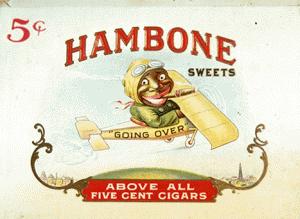 motivation. J.P. Alley, born in 1885, was a cartoonist who, in 1916, joined the Memphis’ paper “Commercial Appeal” on a full-time basis to contribute to the editorial section. He created the cartoon feature “Hambone’s Meditations” of which collections would be published book form in 1917 and 1920. Hambone was the nickname of a certain Tom Hunley, an ex-slave from Greenwood, Mississippi, who had been interviewed late in his life by this young Memphis editorial cartoonist. J.P. Alley was strongly fascinated with Hunley’s humorously philosophical tone, and turned his pithy observations on life into the illustrated column “Hambone’s Meditations”. Hambone was depicted as a black man with long, floppy shoes, sad eyes, and, in the minstrel tradition, with enormous lips. He spoke words of folk wisdom in a black dialect. He corresponded to the contemporary stereotype of the African-American. The cartoon became hugely popular and was promoted as the label of cigar boxes, for instance, depicting Lindberg’s first cross Atlantic flight in 1927. It was the period that the blues and other records, performed by black artists, were distributed on the separated ‘race records’ market in a social environment that was fundamentally racist. Ironically, Alley’s editorial cartoons were in 1923 credited with helping his paper win the Pulitzer Prize for its crusade against the Ku Klux Klan. The irony can only be understood if we see Hambone as the expounder of the journal’s (white) view on the poignant social and political issues dominating the national and international scene of that moment. In the editor’s eyes, the Hambone character was not meant to be a racial instrument, but a communication medium that allowed expressing the journal’s view on contemporary social and political issues.
motivation. J.P. Alley, born in 1885, was a cartoonist who, in 1916, joined the Memphis’ paper “Commercial Appeal” on a full-time basis to contribute to the editorial section. He created the cartoon feature “Hambone’s Meditations” of which collections would be published book form in 1917 and 1920. Hambone was the nickname of a certain Tom Hunley, an ex-slave from Greenwood, Mississippi, who had been interviewed late in his life by this young Memphis editorial cartoonist. J.P. Alley was strongly fascinated with Hunley’s humorously philosophical tone, and turned his pithy observations on life into the illustrated column “Hambone’s Meditations”. Hambone was depicted as a black man with long, floppy shoes, sad eyes, and, in the minstrel tradition, with enormous lips. He spoke words of folk wisdom in a black dialect. He corresponded to the contemporary stereotype of the African-American. The cartoon became hugely popular and was promoted as the label of cigar boxes, for instance, depicting Lindberg’s first cross Atlantic flight in 1927. It was the period that the blues and other records, performed by black artists, were distributed on the separated ‘race records’ market in a social environment that was fundamentally racist. Ironically, Alley’s editorial cartoons were in 1923 credited with helping his paper win the Pulitzer Prize for its crusade against the Ku Klux Klan. The irony can only be understood if we see Hambone as the expounder of the journal’s (white) view on the poignant social and political issues dominating the national and international scene of that moment. In the editor’s eyes, the Hambone character was not meant to be a racial instrument, but a communication medium that allowed expressing the journal’s view on contemporary social and political issues.
“Hambone’s Meditations”, which continued to be published until 1968, would only later be explicitly criticized for its racist character. In the wake of the 1968 strike in Memphis hospitals, schools, and the federal housing authority bodies, and its growth into a major civil 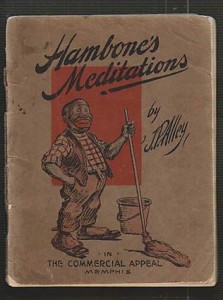 rights struggle, attracting the attention of the national news media, the Hambone caricature was removed from the ‘Commercial Appeal’. Martin Luther King went to Memphis to support the striking employees. It was during this strike that, on April 3rd, King delivered his final speech “I’ve Been to the Mountaintop”. Keith Miller, when discussing the famous speech, highlights that Martin Luther King made it clear to his audience that Memphis newspapers, such as the “Commercial Appeal”, were definitely more racist than they appeared at first sight. Earlier in his speech, King had reminded his audience of “Hambone”, when he dismissed African-American subservience, of the kind epitomized in “Hambone”, as utterly outdated (Miller). A day later, King was assassinated.
rights struggle, attracting the attention of the national news media, the Hambone caricature was removed from the ‘Commercial Appeal’. Martin Luther King went to Memphis to support the striking employees. It was during this strike that, on April 3rd, King delivered his final speech “I’ve Been to the Mountaintop”. Keith Miller, when discussing the famous speech, highlights that Martin Luther King made it clear to his audience that Memphis newspapers, such as the “Commercial Appeal”, were definitely more racist than they appeared at first sight. Earlier in his speech, King had reminded his audience of “Hambone”, when he dismissed African-American subservience, of the kind epitomized in “Hambone”, as utterly outdated (Miller). A day later, King was assassinated.
As well as referring to dance and rhyme with roots in African culture, ‘hambone’ was also, historically, a racial connotation. In American slang, it is still anything but flattering when one calls an African-American a ‘hambone’, meaning he is clownish. There is still another reason we might think of that the NAACP advised against the Richmond baseball team’s use of “Hambone” as the name for its new team. In Southern vernacular, hambone is associated with the act of having sexual intercourse and/or with the genitals (Stephen Calt). The word surfaced in this meaning in several early blues songs. Flipping through the pages of early blues, I found the sexual allusion popping up in at least four songs.
In “I Never Knew What the Blues Were” (OK 8151, 72479-B, April 1924), the blues and jazz singer Virginia Listan, with the piano accompaniment of Clarence Williams, expresses her desire to get sexual satisfaction when she sings: “I ain’t got nobody but I’m gonna get my hambone boiled, oh daddy / I’m gonna take it down home, ’cause these Northern men will let it spoil.” (Calt). A similar appetite is revealed in the 1925 “Southern Woman’s Blues” by Ida Cox, who wants to go back to the sunny South “where (she) can get (her) hambone boiled, because these northern men are about to let (her) poor hambone spoil”. (Debra DeSalvo).
Blues men tapped the same beer. Ed Bell, sometimes placed on the same level as blues monuments such as Charley Patton, but with a more modest discography, recorded in 1927 “Hambone Blues”, as a B-side to the magical “Mamlish Blues” (Paramount 12524). While he turned his back to secular music later in his life, that year he was unambiguous when he shared with us his strong feeling that he “got to move to Cincinnati, (to) get (his) hambone boiled, (since) women in Alabama gon’t let (his) hambone spoil.”
Best known for his first recording of the famous “Roll and Tumble Blues”, the rough-voiced 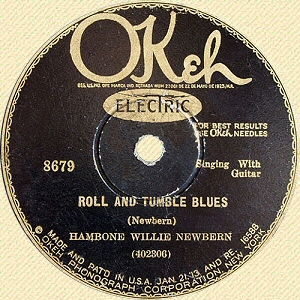 singer Hambone Willie Newbern, cousin of ‘Sleepy’ John Estes, in March, 1929, recorded in Atlanta a B-side for his “Shelby County Workhouse Blues” (Okeh 8740). The song narrates his arrest for vagrancy when he came down from Marked Tree, Arkansas: “I left Memphis Tennessee, on my way back to dear old Marked Tree; I think I’ll hambone my baby says, ‘Jam up above the knee”.
singer Hambone Willie Newbern, cousin of ‘Sleepy’ John Estes, in March, 1929, recorded in Atlanta a B-side for his “Shelby County Workhouse Blues” (Okeh 8740). The song narrates his arrest for vagrancy when he came down from Marked Tree, Arkansas: “I left Memphis Tennessee, on my way back to dear old Marked Tree; I think I’ll hambone my baby says, ‘Jam up above the knee”.
Note that it was not uncommon for the early blues singers to incorporate food terminology in their music as metaphors to reflect sexual needs and acts (J.T. Edge). Both male and female blues singers used food items in their lyrics to make the topic of sex more socially acceptable. The songs substituted for parts of the human anatomy terms as banana, pig meat, jellyroll, jelly bean, and pie. A biscuit roller evoked the image of an attractive young woman with desirable sexual skills. Coffee grinding had the connotation, as did boiling the hambone, of sexual intercourse. Blues presented sexual desire in an ingenious way reducing it however, at the same time, to a simple organic or mechanical act (Robert Springer).
With the above various meanings of ‘hambone’ in mind, ranging from a culinary ingredient, a strong rhythm ic dance and a degrading nickname to an imaginative reference to sex, we would understand why naming the Richmond baseball team ‘Hambones’ would have provoked chuckling with some, and feelings of indignation with others. “Flying Squirrels” was after all not that bad as a final choice.
ic dance and a degrading nickname to an imaginative reference to sex, we would understand why naming the Richmond baseball team ‘Hambones’ would have provoked chuckling with some, and feelings of indignation with others. “Flying Squirrels” was after all not that bad as a final choice.

For full source reference on Erwin's article, we encourage you to check out his site.
www.myblues.eu
Copyright 2022 BLUES JUNCTION Productions. All rights reserved.
BLUES JUNCTION Productions
7343 El Camino Real
Suite 327
Atascadero, CA 93422-4697
info
